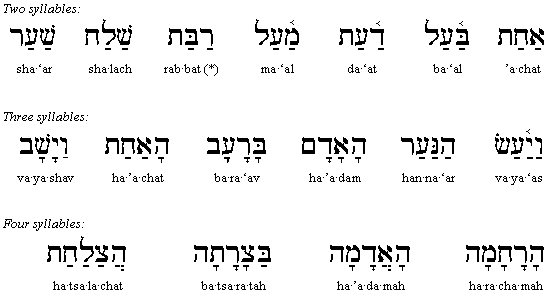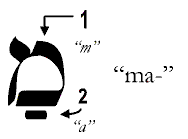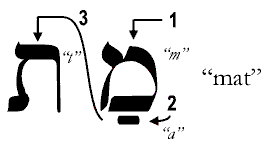|
|
||||||||||||||||||||||
 |
||||||||||||||||||||||
|
Learn Hebrew |
||||||||||||||||||||||
 |
||||||||||||||||||||||
|
Audio Tanakh |
||||||||||||||||||||||
 |
||||||||||||||||||||||
|
Hebrew Training |
||||||||||||||||||||||
|
|
||||||||||||
|
The first vowel group you will learn is sometimes called the "A-type" because it indicates an "ah" sound (as in "yacht" or "aqua") when combined with a Hebrew consonant (i.e., letter). The "simple" A-type vowels have the following pattern: |
 |
||||||||||
|
Note that the "X" refers to any Hebrew letter (for example Aleph, Bet, and so on) and the rectangular box below the letter refers to a one the following types of vowel marks (nikkudim): |
||||||||||
 |
||||||||||
|
|
||||||||||
|
Notes: |
||||||||||
|
||||||||||
|
Full A-Type Vowel |
||||||||||
 |
||||||||||
|
Note that the "X" refers to any Hebrew letter (for example Aleph, Bet, Gimmel, and so on) and the rectangular box below the letter refers to a vowel mark location. When the letter Hey follows a letter with a Qamets or Patach, it functions not as a consonant, but as a vowel letter. This is called a "consonantal vowel" and the result is called a "mixed" or "full" vowel. |
 |
|||
|
Notes:
|
|||
|
Basic Syllables |
|||
|
|
Open Syllables: |
||||||||||||||||||||||||||
 |
||||||||||||||||||||||||||
|
Closed Syllables: |
||||||||||||||||||||||||||
 |
||||||||||||||||||||||||||
|
Reading Examples: |
||||||||||||||||||||||||||
 |
||||||||||||||||||||||||||
|
Practice Readings |
||||||||||||||||||||||||||
 |
||||||||||||||||||||||||||
|
* The dot (dagesh) in the Bet indicates a "doubling" of the letter, causing the previous syllable to be closed (dagesh chazak). |
||||||||||||||||||||||||||
|
Quick Summary: |
||||||||||||||||||||||||||
 |
||||||||||||||||||||||||||
|
Transliteration Practice: |
||||||||||||||||||||||||||
 |
||||||||||||||||||||||||||
|
Hebrew for Christians |
||||||||||||||||||||||||||
|
||||||||||||||||||||||||||

